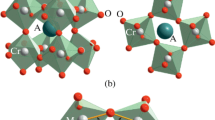Abstract
In this paper the Mossbauer spectra of a chromite at 140K 200K and 298K were measured. Next nearest neighbor effects were used to explain the spectra of the chromite, and multiple doublets of Fe2+ ions on the A sites were caused by the different cation combinations on 12 next nearest neighbor B sites. The quandrupole splitting of each of mult iple Fe2+ doublets decreases with increasing temperature.
Similar content being viewed by others
References
Li Zhe and J.G. Stevens, Scientia Sincia (Series B) XXIX (1986) 889.
R. Inglas, Phys. Rev., A 133 (1964) 784.
M.D. Osborne, M.E. Fleet and G.M. Bancroft, J. Sol. State Chem., 53 (1984) 174.
Author information
Authors and Affiliations
Rights and permissions
About this article
Cite this article
Zhe, L., Mingzhi, J., Wei, H. et al. Next nearest neighbor effect in chromite. Hyperfine Interact 41, 819–822 (1988). https://doi.org/10.1007/BF02400516
Issue Date:
DOI: https://doi.org/10.1007/BF02400516



